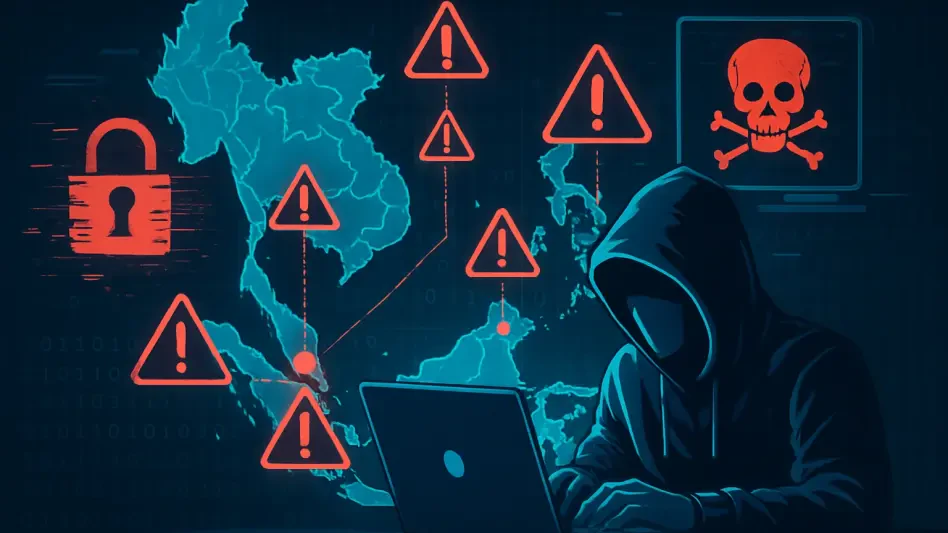The expansive cyberattacks orchestrated by a subgroup within the notorious Sandworm, a Russian state-sponsored hacking group, have raised significant concerns globally. Dubbed “BadPilot” by the Microsoft Threat Intelligence team, this subgroup has been linked to a multi-year clandestine operation targeting over 15 countries. The scope and scale of their activities signify a significant evolution in Sandworm’s operational footprint and methodology, particularly in light of geopolitical developments such as the Russo-Ukrainian war.
Geographical and Sectoral Spread
Global Reach of BadPilot’s Operations
BadPilot’s operations span continents, including North America, Europe, Africa, Asia, and Australia. Specific targets include countries like Angola, Argentina, Australia, Canada, China, Egypt, India, Kazakhstan, Myanmar, Nigeria, Pakistan, Turkey, and Uzbekistan. This widespread geographical reach highlights the group’s ability to infiltrate diverse regions, making their presence felt on a global scale. The diversity in location suggests that BadPilot is leveraging geopolitical tensions, technological disparities, and regional vulnerabilities to maximize their impact. As they exploit these varied environments, it becomes increasingly challenging for international cybersecurity teams to predict and preempt their next moves.
Furthermore, the extensive geographical distribution of their attacks reveals their operational sophistication and flexibility. They are not constrained by regional boundaries but instead adopt a holistic approach, adjusting their strategies and tools to the specific conditions and weaknesses of each target region. This global penetration demands a coordinated international response, as isolated national efforts may not suffice to counter the multifaceted threat. The worldwide nature of their targets necessitates a reevaluation of global cybersecurity protocols and partnerships to effectively address and neutralize this pressing global issue.
Diverse Sectoral Targets
The subgroup’s targets are not limited to a single sector. They have attacked a variety of industries, including energy, oil and gas, telecommunications, shipping, and arms manufacturing. Additionally, international governments have also been on their radar. This diversity in sectoral targets underscores the group’s strategic intent to disrupt critical infrastructures across multiple domains. The focus on vital sectors indicates that BadPilot aims to cause maximum disruption and capitalize on the potential ripple effects that could destabilize economies and societies relying on these essential services.
By targeting vital sectors, BadPilot enhances the potential for widespread disruption and chaos. Energy and telecommunications, for example, are cornerstones of modern infrastructure; any prolonged disruption in these areas can lead to broader systemic breakdowns and significantly impact daily life. Additionally, attacking arms manufacturers not only jeopardizes national security but also has far-reaching implications for global defense dynamics. The deliberate targeting of such critical infrastructures implies a well-conceived strategy intended to weaken or destabilize nations by striking at their core operational and logistical frameworks. Such calculated moves highlight the pressing need for reinforced security measures within these pivotal sectors to safeguard against such cyber onslaughts.
Historical Context and Evolution
Sandworm’s Origins and Evolution
Sandworm, also known as Seashell Blizzard (formerly Iridium) by Microsoft, has been active since at least 2013. Initially, their focus was primarily on Eastern Europe. However, recent activities indicate a substantial geographical expansion, targeting a broader range of sectors and regions beyond their historical focus. This evolution marks a significant shift in their operational strategy, reflecting an adaptability and responsiveness to the shifting geopolitical landscape. Sandworm’s historical persistence and adaptability in their tactics offer insights into their long-term strategies and objectives, demonstrating a pattern that cybersecurity experts must diligently track and analyze.
Over the years, Sandworm’s evolution has seen them transition from simple cyber-attacks to more sophisticated and impactful operations. Their expanding reach and increased complexity in methodologies showcase their growing capabilities and resources. As they extend their focus from a regional to a global scale, the implications for international cybersecurity are profound. Their ability to continually adapt and refine their strategies means that global security infrastructure must also evolve to keep pace. This ongoing evolution necessitates a dynamic approach to cybersecurity—one that anticipates future developments and is ready to counteract increasingly complex threats from groups like Sandworm.
Impact of Geopolitical Developments
The Russo-Ukrainian war has played a pivotal role in shaping Sandworm’s recent activities. The conflict has provided a backdrop for the group’s expanded operations, aligning their cyberattacks with broader geopolitical objectives. This alignment suggests a strategic intent to destabilize critical infrastructures in geopolitically significant regions. The war has not only provided the motive but also the means for Sandworm to intensify their efforts, leveraging the chaos and uncertainty to their advantage. Understanding the geopolitical context is crucial for forming effective countermeasures against such state-sponsored cyber threats.
As the conflict escalated, Sandworm’s operations mirrored the intensifying geopolitical strife, indicating that their activities are not in isolation but part of a concerted effort to advance Russian interests. This strategic alignment underscores the intersection of cyber warfare and traditional geopolitical strategies, revealing how state-sponsored groups like Sandworm utilize cyber capabilities to augment physical military maneuvers and political objectives. Consequently, the nature of cyber threats has evolved from mere technical phenomena into intricate tools of geopolitical strategy, necessitating a comprehensive approach that incorporates political, military, and technological intelligence to effectively counter these sophisticated cyber-offensives.
Campaign Evolution and Techniques
Blend of Opportunistic and Targeted Attacks
BadPilot’s operations have evolved to include a blend of opportunistic “spray and pray” attacks and highly targeted intrusions. This dual approach allows them to cast a wide net while also focusing on high-value targets. Their methods have included exploiting known security vulnerabilities to gain initial access, showcasing their adaptability and technical prowess. Employing such a diverse set of tactics makes it difficult for defenders to anticipate and defend against their attacks, as it demands vigilance across a broad spectrum of potential vulnerabilities.
The adaptability in their tactics is a testament to their understanding of modern cyber defense mechanisms and how to circumvent them. Opportunistic attacks often serve as a scattershot approach, ensuring that any weak link can be exploited, while targeted intrusions focus on high-value assets ensuring high impact for their efforts. By combining these approaches, BadPilot maximizes their chances of success and persistence in compromised environments. This flexibility in their attack strategies complicates efforts to predict and mitigate their actions, thereby underscoring the need for a proactive and comprehensive cybersecurity posture that addresses both broad-based and targeted threats.
Exploitation of Known Vulnerabilities
The subgroup has exploited vulnerabilities in widely used systems such as Microsoft Exchange Server, Zimbra Collaboration, Openfire, and Fortinet FortiClient EMS. By leveraging these known vulnerabilities, they have been able to gain initial access to their targets. This tactic underscores the critical importance of timely patching and updates in cybersecurity. Organizations failing to keep their systems updated provide easy entry points for attackers, who then exploit these weaknesses to infiltrate networks and establish a foothold for further malicious activities. This exploitation of known vulnerabilities highlights a significant gap in many organizations’ cybersecurity practices.
Persistent exploitation of known vulnerabilities suggests a gap between threat actors’ capabilities and organizations’ defensive measures. Despite the widespread availability of patches and updates, many organizations lag in their implementation, leaving them vulnerable to attacks. The reliance on exploiting documented vulnerabilities signifies that attackers are capitalizing on predictable weaknesses. Institutional inertia and the inability to prioritize cybersecurity measures effectively open the door to such breaches. This underscores the necessity for robust patch management protocols and the constant reinforcement of cybersecurity awareness and practices within organizations to ensure that these vulnerabilities are rectified before attackers can exploit them.
Tools and Malware Utilized
Mix of Criminally Sourced Tools and Custom-Developed Malware
BadPilot employs a mix of criminally-sourced tools and custom-developed malware. Tools like DarkCrystal RAT (DCRat), Warzone, and RADTHIEF (also known as Rhadamanthys Stealer) are part of their arsenal. These tools, combined with custom-developed malware, enable them to maintain persistent access to compromised systems. The use of criminally sourced tools implies a thriving underground market where cybercriminals and state-sponsored actors can exchange resources, further complicating the attribution and analysis of such attacks. This blend of tools demonstrates BadPilot’s capability to mix readily available resources with specialized, tailor-made solutions to continue their operations.
The integration of these tools into their operations demonstrates a high level of sophistication and adaptability. Custom-developed malware can be tailored to specific targets, evading standard detection mechanisms and creating unique challenges for cybersecurity professionals. This combination of off-the-shelf tools and bespoke malicious software allows BadPilot to adapt rapidly to different environments and objectives, showcasing their operational flexibility. It underlines the necessity for advanced threat detection and response systems that can adapt to both common threats and bespoke ones, ensuring a multi-layered defensive posture capable of handling a variety of intrusion methods used by advanced persistent threats like BadPilot.
Use of Legitimate Software for Malicious Purposes
The group also uses legitimate software like Atera Agent and Splashtop Remote Services for remote access. These tools, while legitimate, are sometimes extended into additional payloads for credential acquisition and data exfiltration. This tactic highlights their ability to repurpose legitimate software for malicious purposes, complicating detection and mitigation efforts. Using legitimate software tools allows BadPilot to blend into normal network activity more easily, making it harder for security systems to distinguish between legitimate and malicious activities. This cunning methodology challenges conventional security paradigms, as traditional detection tools may not always flag legitimate software being used with malicious intent.
Moreover, the repurposing of legitimate software underscores BadPilot’s resourcefulness in leveraging available technology. This approach reduces the likelihood of immediate detection, as these tools are commonly used for legitimate administrative purposes. Their misuse for malicious purposes illustrates the evolving nature of cyber threats, where attackers continually find innovative ways to hijack trusted systems and software. This scenario accentuates the crucial need for behavioral analysis and machine learning in cybersecurity to detect anomalous usage patterns, providing an enhanced layer of security capable of discerning legitimate uses from nefarious activities.
Strategic Objectives and Operational Maturity
Alignment with Russian Geopolitical Interests
Sandworm’s activities suggest a strategic objective aligned with Russian geopolitical interests. By targeting critical infrastructures in geopolitically significant regions, they aim to destabilize these areas. This alignment reflects a sophisticated understanding of both political and cyber landscapes, making their operations highly strategic. Their focused attacks on critical infrastructure are not random but calculated moves to weaken adversaries and advance Russia’s broader geopolitical goals. This makes BadPilot’s activities not just acts of cybercrime but also instruments of national policy, embedding cyber capabilities within larger strategic frameworks.
In such a context, the group operates as a tool for statecraft, employing cyber tactics to achieve objectives that align with Russian geopolitical ambitions. By disrupting critical infrastructures, Sandworm can indirectly influence political and economic stability in target regions, thereby exerting pressure without direct military involvement. This dual-use strategy blurs the line between traditional military operations and cyber warfare, creating a complex landscape where digital threats contribute to physical and political outcomes. This scenario underscores the necessity for international collaboration and vigilance to counteract the multilayered threats posed by sophisticated state-sponsored groups like Sandworm.
Persistent and Multifaceted Threats
The group’s methodologies for maintaining access showcase significant operational maturity. They employ various techniques for persistence, including deploying legitimate remote access software, web shells, and malicious modifications to Outlook Web Access (OWA) sign-in pages. This persistence underscores the necessity for robust, multifaceted defense strategies to counter such threats. Their ability to remain embedded within systems for extended periods presents a critical challenge for cybersecurity efforts, as it allows them to continually harvest data and execute further attacks from a supposed safe haven within compromised networks.
The sophisticated persistence mechanisms reflect not only advanced technical know-how but also a deeply strategic approach to cyber warfare. By ensuring continued access, Sandworm can maintain a foothold in critical systems, positioning themselves to execute long-term espionage or disruptive activities. This persistent threat necessitates an equally sophisticated and layered defensive strategy that combines prevention, continuous monitoring, and rapid response measures. To counteract such embedded threats, organizations must adopt comprehensive cybersecurity policies that encompass regular audits, thorough incident response planning, and advanced monitoring techniques to detect and neutralize unauthorized access promptly.
Overarching Trends and Consensus Viewpoints
Expansion of Operational Scope
The transition from a focus on Eastern Europe to a more global scale marks a significant operational shift for Sandworm. This expansion highlights a trend towards more diverse and globally distributed cyber espionage and attack campaigns. It also underscores the growing threat posed by state-sponsored hacking groups on a global scale. The broader scope of operations indicates a strategic shift to increase impact and influence. As Sandworm diversifies its targets, the global community must recognize the increased risk and adapt their defensive strategies accordingly.
By expanding their scope, Sandworm has adapted to the evolving global landscape, seeking vulnerabilities wherever they may be found. This strategic shift signifies a reckoning for global cybersecurity protocols, urging a move from region-specific strategies to comprehensive, internationally-coordinated defenses. The shift to a global operational scope implies a need for broader intelligence sharing, cross-border collaborations, and unified defensive postures to tackle the ever-increasing complexity of cyber threats. Thus, recognizing and responding to this operational expansion is pivotal to preempting and mitigating potential disruptions across various sectors worldwide.
Reliance on Known Vulnerabilities and Criminal Markets
Global concerns have surged due to extensive cyberattacks executed by a subgroup within Sandworm, a hacking group sponsored by the Russian state. These attacks, identified as “BadPilot” by the Microsoft Threat Intelligence team, represent a sophisticated and prolonged campaign affecting over 15 nations. This subgroup’s activities reflect a notable expansion and evolution in Sandworm’s strategies and targets, especially in the context of current geopolitical events such as the Russo-Ukrainian war.
The sophistication and scope of “BadPilot” underscore the increasing complexity of cyber warfare tactics. Sandworm’s alignment with state-sponsored initiatives suggests a strategic approach that aligns with broader national interests, using cyber operations as tools for geopolitical influence. As these cyber offensives grow in scale and intricacy, the global community faces heightened challenges in combatting and mitigating such threats. These developments underline the pressing need for international cooperation and robust cybersecurity frameworks to counteract the ever-evolving landscape of cyber threats.







